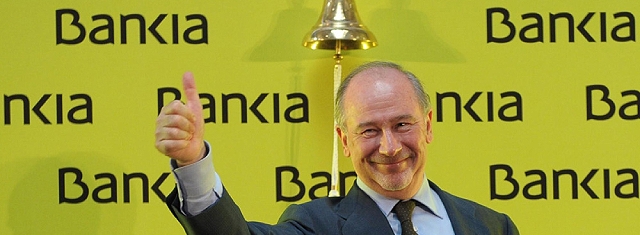Business
The Spanish Courthouse acquits the 34 defendants for Bankia IPO
Now immersed in a merger with Caixabank

Rodrigo Rato was a former IMF president (Source: Bankia)
USPA NEWS -
The Criminal Chamber of the Spanish Courthouse agreed on Tuesday to acquit the 34 defendants in the trial for Bankia's IPO, including the former president of the entity and the IMF, Rodrigo Rato, for crimes of fraud against investors and accounting falsehood. The 442-page ruling highlights that the IPO had the approval of all supervisors - Bank of Spain, CNMV, FROB and EBA -, that the prospectus contained “broad and accurate“ financial and non-financial information, and that in the trial only generic attitudes of the accused were exposed and not concrete acts.
The resolution establishes three different blocks. The first deals with the constitution of Banco Financiero y de Ahorro (BFA) and the accounts for 2010, and highlights that “the integration of the seven Savings Banks that made up BFA was promoted by the economic and financial authorities, which exercised a strong pressure to undertake integration processes in the Spanish financial system with the aim of achieving in the short term reinforcing solvency and increasing the capacity to withstand extreme delinquency scenarios in the framework of a sharp deterioration of the cycle.“ The second block of the ruling focuses on the birth of BANKIA and its IPO, and the third develops the individual and consolidated annual accounts of BFA and BANKIA for 2011.
Benefit from all institutions
The ruling highlights that the IPO had the approval of all institutions: “both the decision to go public and the determination to do so with the double-bank structure were resolutions entirely contemplated by the Bank of Spain, which also approved them after calibrating the advantages and disadvantages that these decisions entailed,“ to later determine that “what is clearly evident is that the process that culminated in the listing of BANKIA was intensively supervised with success by the Bank of Spain, the CNMV, the FROB and the EBA, ultimately having the approval of all the Institutions."
In relation to the prospectus for the IPO, it is stated that it contained extensive and accurate financial and non-financial information, indicating in this regard: “In short, the financial information included in the prospectus was more than enough for wholesale investors and retailers formed a reasoned criterion on the value of the company that was being offered, information that had been prepared with the supervision and obeying the requirements of the Bank of Spain, being later endorsed by the CNMV when registering the Prospectus.“
The Chamber recalls that the Prosecutor, in his provisional conclusions, stated that the economic and financial information that BANKIA supplied to the market on the occasion of the IPO “cannot be materially classified as false to the extent that it did not violate the regulations then in force and they complied with the requirements of the regulator, which came to expressly authorize some accounting decisions," although "they did not contribute to making the fair image of the entity look properly."
Regarding the non-financial information subscribed in the prospectus, the ruling indicates that "up to 36 risks to the investment in BANKIA shares are described that were highlighted in the first point of the summary of its content." It adds that "the comprehensive and clear risk description also contains a caveat that anyone would understand."
Bankia viability
The ruling argues that at the time of its IPO, Bankia was viable and adds that the implied non-viability “is based mainly on the four emails in which the opinion of the Bank of Spain inspector sent on April 8 and 14, and May 10 and 16, 2011 to other members of the Inspection Service of the Bank of Spain, including their superiors, opinions of the inspector that were never reflected in any official document, and it is stated: “for their part, for the Bank of Spain it was viable, not only at the time of the IPO but also in April 2012, affirming then that the Recapitalization Plans presented by this bank, in the opinion of the General Supervision Directorate, should be subject to approval because “the management team understands, and has shown it with determination, that it can manage BANKIA satisfactorily as long as the economy recovers. In this sense, the diagnosis made is considered realistic and the measures that are being implemented are correct, as well as the details of their execution also seem promising.“Regarding the third of the blocks, dedicated to the falsification of the individual and consolidated annual accounts of BFA and BANKIA for fiscal year 2011, it is stated in the judgment that the Prosecutor, in the provisional conclusions, maintained that said accounts "could not be considered as such, strictly speaking, specifying that they were only those that, after their formulation within a maximum period of three months, counted from the close of the fiscal year, have been reviewed and verified by the account auditor and approved by the General Meeting In such a way that only later, when they are deposited in the Mercantile Registry within the month following their approval, are the accounts public. All of this, as provided in articles 253, 263, 283, 272, 279 and 281 of the Capital Companies Law and those that are the subject of this procedure, “were neither audited nor approved by the General Meetings of BFA and from BANKIA. Therefore, legally, they did not become 'annual accounts' and they cannot constitute the material object of the crime of falsehood due to the lack of harmful potential, given that they were not available to accounting users (shareholders, creditors, investors ... ), that is, they never entered the commercial legal trade."
No specific facts were imputed
Throughout their sentence, the judges highlighted in several sections the absence of specific acts attributed to the defendants. According to the Courthouse, this lack of specific mentions to the people who sat on the bench was the predominant note during the trial and this is established in the sentence: “The absence of specific mentions to the accused, who sat in the bench destined for them, by the numerous witnesses who, after having given exhaustive statements in the investigation phase, did it again in Court, and also by the experts, or by documentary references, etc. incriminating content. In the plenary session, no one named them, neither for better nor for worse, so that most of the accused persons fell into oblivion during the Oral Trial, only their identities were remembered by the Public Ministry in the final conclusions process. to now direct his accusation against those he previously accused and, in addition, against those he did not accuse, members of the Audit and Compliance Committees of BFA and BANKIA, without us knowing for sure on the basis of what led to such a change in position held by the Public Accusation.“
The Chamber concludes that the accusations during the trial only attributed generic attitudes to the defendants, which cannot be included in an account of the proven facts of a sentence “after a brief reading of the same, the very few references that are made to the persons subjected to our prosecution, an unavoidable consequence of the absence of concrete facts imputed by the Public Prosecutor's Office and other accusations to the accused, the same ones, to whom they engage, in the best of cases, generic attitudes, which have no place in a story of proven facts of a conviction and, of course, prevent the accused from adequately defending themselves against something so ethereal, so abstract, so indefinite as is the observance of an attitude.“
Liability for this article lies with the author, who also holds the copyright. Editorial content from USPA may be quoted on other websites as long as the quote comprises no more than 5% of the entire text, is marked as such and the source is named (via hyperlink).






